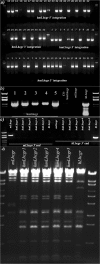Assisted large fragment insertion by Red/ET-recombination (ALFIRE)--an alternative and enhanced method for large fragment recombineering
- PMID: 17517785
- PMCID: PMC1904275
- DOI: 10.1093/nar/gkm250
Assisted large fragment insertion by Red/ET-recombination (ALFIRE)--an alternative and enhanced method for large fragment recombineering
Abstract
Functional genomics require manipulation and modification of large fragments of the genome. Such manipulation has only recently become more efficient due to the discovery of different techniques based on homologous recombination. However, certain limitations of these strategies still exist since insertion of homology arms (HAs) is often based on amplification of DNA sequences with PCR. Large quantities of PCR products longer than 4-5 kb can be difficult to obtain and the risk of mutations or mismatches increases with the size of the template that is being amplified. This can be overcome by adding HAs by conventional cloning techniques, but with large fragments such as entire genes the procedure becomes time-consuming and tedious. Second, homologous recombination techniques often require addition of antibiotic selection genes, which may not be desired in the final construct. Here, we report a method to overcome the size and selection marker limitations by a two- or three-step procedure. The method can insert any fragment into small or large episomes, without the need of an antibiotic selection gene. We have humanized the mouse luteinizing hormone receptor gene (Lhcgr) by inserting a approximately 55 kb fragment from a BAC clone containing the human Lhcgr gene into a 170 kb BAC clone comprising the entire mouse orthologue. The methodology is based on the rationale to introduce a counter-selection cassette flanked by unique restriction sites and HAs for the insert, into the vector that is modified. Upon enzymatic digestion, in vitro or in Escherichia coli, double-strand breaks are generated leading to recombination between the vector and the insert. The procedure described here is thus an additional powerful tool for manipulating large and complex genomic fragments.
Figures



Similar articles
-
A highly efficient Escherichia coli-based chromosome engineering system adapted for recombinogenic targeting and subcloning of BAC DNA.Genomics. 2001 Apr 1;73(1):56-65. doi: 10.1006/geno.2000.6451. Genomics. 2001. PMID: 11352566
-
Combination of overlapping bacterial artificial chromosomes by a two-step recombinogenic engineering method.Nucleic Acids Res. 2003 Aug 1;31(15):e81. doi: 10.1093/nar/gng081. Nucleic Acids Res. 2003. PMID: 12888533 Free PMC article.
-
Recombineering: a powerful new tool for mouse functional genomics.Nat Rev Genet. 2001 Oct;2(10):769-79. doi: 10.1038/35093556. Nat Rev Genet. 2001. PMID: 11584293 Review.
-
[Recombineering and its application].Yi Chuan Xue Bao. 2003 Oct;30(10):983-8. Yi Chuan Xue Bao. 2003. PMID: 14669518 Review. Chinese.
-
Counter-selection recombineering of the baculovirus genome: a strategy for seamless modification of repeat-containing BACs.Nucleic Acids Res. 2010 Sep;38(16):e166. doi: 10.1093/nar/gkq596. Epub 2010 Jul 9. Nucleic Acids Res. 2010. PMID: 20621982 Free PMC article.
Cited by
-
A new positive/negative selection scheme for precise BAC recombineering.Mol Biotechnol. 2009 May;42(1):110-6. doi: 10.1007/s12033-009-9142-3. Epub 2009 Jan 22. Mol Biotechnol. 2009. PMID: 19160076 Free PMC article.
-
A novel bioassay for quantification of surface Cannabinoid receptor 1 expression.Sci Rep. 2020 Oct 23;10(1):18191. doi: 10.1038/s41598-020-75331-y. Sci Rep. 2020. PMID: 33097803 Free PMC article.
-
Dual-In/Out strategy for genes integration into bacterial chromosome: a novel approach to step-by-step construction of plasmid-less marker-less recombinant E. coli strains with predesigned genome structure.BMC Biotechnol. 2008 Aug 12;8:63. doi: 10.1186/1472-6750-8-63. BMC Biotechnol. 2008. PMID: 18699991 Free PMC article.
-
Recombineering: a homologous recombination-based method of genetic engineering.Nat Protoc. 2009;4(2):206-23. doi: 10.1038/nprot.2008.227. Nat Protoc. 2009. PMID: 19180090 Free PMC article.
-
A highly efficient in vivo plasmid editing tool based on CRISPR-Cas12a and phage λ Red recombineering.J Genet Genomics. 2019 Sep 20;46(9):455-458. doi: 10.1016/j.jgg.2019.07.006. Epub 2019 Sep 10. J Genet Genomics. 2019. PMID: 31607505 Free PMC article. No abstract available.
References
-
- Sternberg NL. Cloning high molecular weight DNA fragments by the bacteriophage P1 system. Trends Genet. 1992;8:11–16. - PubMed
-
- Ioannou PA, Amemiya CT, Garnes J, Kroisel PM, Shizuya H, Chen C, Batzer MA, de Jong PJ. A new bacteriophage P1-derived vector for the propagation of large human DNA fragments. Nat. Genet. 1994;6:84–89. - PubMed
-
- Copeland NG, Jenkins NA, Court DL. Recombineering: a powerful new tool for mouse functional genomics. Nat. Rev. Genet. 2001;2:769–779. - PubMed
-
- Muyrers JP, Zhang Y, Stewart AF. ET-cloning: think recombination first. Genet. Eng. (NY) 2000;22:77–98. - PubMed
Publication types
MeSH terms
Substances
Grants and funding
LinkOut - more resources
Full Text Sources
Other Literature Sources
Research Materials

